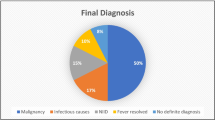Abstract
Purpose
The role of FDG-PET and PET/CT in patients whose main symptom is prolonged fever has not yet been defined. We addressed this topic in a retrospective study.
Methods
A total of 124 patients (referred between May 2001 and December 2004) with fever of unknown origin or prolonged fever due to a suspected infection of a joint or vascular prosthesis were included in the study. The patients underwent either FDG-PET or FDG-PET/CT scanning. Sixty-seven patients had a negative focal FDG-PET finding; in this group the method was regarded as unhelpful in determining a diagnosis, and no further investigation was pursued. We tried to obtain clinical confirmation for all patients with positive PET findings.
Results
Fifty-seven (46%) patients had positive FDG-PET findings. In six of them no further clinical information was available. Fifty-one patients with positive PET findings and 118 patients in total were subsequently evaluated. Systemic connective tissue disease was confirmed in 17 patients, lymphoma in three patients, inflammatory bowel disease in two patients, vascular prosthesis infection in seven patients, infection of a hip or knee replacement in seven patients, mycotic aneurysm in two patients, abscess in four patients and AIDS in one patient. In eight (16%) patients the finding was falsely positive.
Conclusion
FDG-PET or PET/CT contributed to establishing a final diagnosis in 84% of the 51 patients with positive PET findings and in 36% of all 118 evaluated patients with prolonged fever.




Similar content being viewed by others
References
Alavi A, Zhuang H. PET Imaging in infectious diseases. In: Valk PE, Bailey DL, Townsend DW, Maisey MN, editors. Positron emission tomography. Lonodon: Springer; 2003. p. 727–39
Petersdorf RG, Beeson PB. Fever of unexplained origin: report on 100 cases. Medicine (Baltimore) 1961;40:1–30
Wong SY, Lam MS. Pyrexia of unknown origin—approach to management. Singapore Med J 1995;36(2):204–8
Knockaert DC, Dujardin KS, Bobbaers HJ. Long-term follow up of patients with undiagnosed fever of unknown origin. Arch Intern Med 1996;156(6):618–20
Buysschaert I, Vanderchueren S, Blockmans D, Mortelmans L, Knockaert D. Contribution of (18) fluoro-deoxyglucose positron emission tomography to the work-up of patients with fever of unknown origin. Eur J Intern Med 2004;15(3):151–6
Bleeker-Rovers CP, de Klein EMHA, Corstens FHM, van der Meer JWM, Oyen WJG. Clinical value of FDG-PET in patients with fever of unknown origin and patients suspected of focal infection or inflammation. Eur J Nucl Med Mol Imaging 2004;31(1):29–37
Webb M, Chambers A, AL-Nahhas A, Mason JC, Maudlin L, Rahman L, et al. The role of 18F-FDG PET in characterising disease activity in Takayasu arteritis. Eur J Nucl Med Mol Imaging 2004;31(5):627–34
Brodmann M, Lipp RW, Passath A. The role of 2-F-18-fluoro-2-deoxy-D-glucose positron emission tomography in the diagnosis of giant cell arteritis of the temporal arteries. Rheumatology 2004;43:241–2
Mochizuki Y, Fujii H, Yasuda S, Nakahara T, Takahashi W, Ide M, et al. FDG accumulation in aortic walls. Clin Nucl Med 2001;26(1):68–9
Yun M, Yeh D, Araujo LI, Jang S, Newberg A, Alavi A. F-18 FDG uptake in the large arteries: a new observation. Clin Nucl Med 2001;26(4):314–9
de Kleijn EM, Vandenbroucke JP, ven der Meer JW. Fever of unknown origin (FUO). I. A. prospective multicenter study of 167 patients with FUO using fixed epidemiologic entry criteria. The Netherlands FUO Study Group. Medicine (Baltimore) 1997;76(6):392–400
Belohlavek O, Votrubova J, Skopalova M, Fencl P. The detection of aortic valve infection by FDG-PET/CT in a patient with infection following total knee replacement. Eur J Nucl Med Mol Imaging 2005;32(4):518
Love C, Marwin SE, Tomas MB, Krauss EX, Tronco GG, Bhargava KK, et al. Diagnosing infection in the failed joint replacement: a comparison of coincidence detection 18F-FDG and 111In-labeled leukocyte/99Tc-sulfur colloid marrow imaging. J Nucl Med 2004;45(11):1864–71
Vanquikenborne B, Maes A, Nuyts J, Van Acker F, Stuyck J, Mulier M, et al. The value of 18FDG-PET for the detection of infected hip prosthesis. Eur J Nucl Med Mol Imaging 2003;30(5):705–15
Meller J, Sahlmann CO. F-18-FDG hybrid camera PET in patients with postoperative fever. Nuklearmedizin 2002;41(1):22–9
De Winter F, Gemmel F. 18-Fluorine fluorodeoxyglucose positron emission tomography for the diagnosis of infection in the postoperative spine. Spine 2003;28(12):1314–9
Zhuang H, Chacko TH, Hickeson M, Stevenson K, Feng Q, Ponzo F, et al. Persistent non-specific FDG uptake on PET imaging following hip arthroplasty. Eur J Nucl Med Mol Imaging 2002;29(10):1328–33
Author information
Authors and Affiliations
Corresponding author
Rights and permissions
About this article
Cite this article
Jaruskova, M., Belohlavek, O. Role of FDG-PET and PET/CT in the diagnosis of prolonged febrile states. Eur J Nucl Med Mol Imaging 33, 913–918 (2006). https://doi.org/10.1007/s00259-006-0064-z
Received:
Accepted:
Published:
Issue Date:
DOI: https://doi.org/10.1007/s00259-006-0064-z




